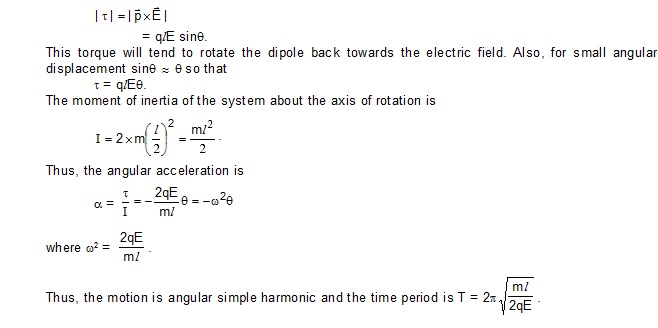Solved Examples
EXAMPLE 29.1
Two charges 10 mC and mC are placed at points A and B separated by a distance of 10 cm. Find the electric field at a point P on the perpendicular bisector of AB at a distance of 12 cm from its middle point.
Sol.
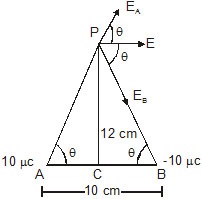
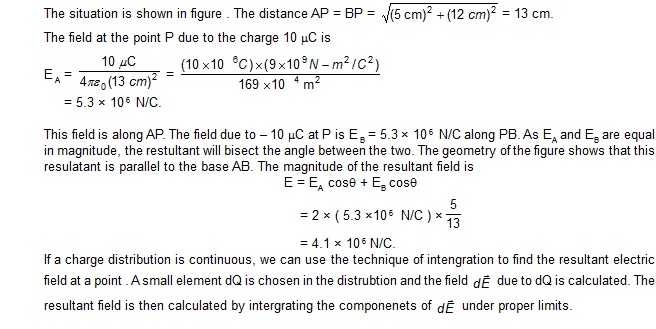
EXAMPLE 29.2
A ring of radius a contains a charge q distribhuted uniformly over its length. Find the electric field at a point on the axis of the ring at a distance x from the centre.

Sol.
Fig. shows the sistuation. Let us consider a small element of the ring at the point A having a charge dQ. The field at P due to this element is
![]()
By symmetry, the field at P will be along the axis OP.
The component of dE along this direction is
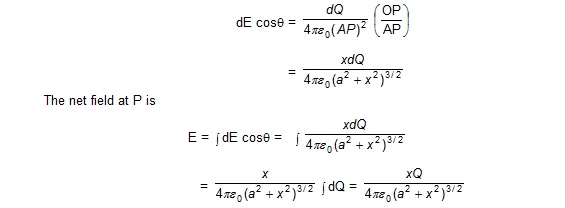
EXAMPLE 29.3
Three particles, each having a charge of 10 mC, are placed at the vertices of an equilaterial triangle of side 10 cm. Find the work done by a person in pulling them apart to infinite separations.
Sol.
The potential energy of the system in the initial condition is

When the charges are infinitely separated, the potential energy is reduced to zero. If we assume that the charge do not get kinetic energy in the process, the total mechanical energy of the system decreases by 27J. Thus, the work done by the person on the system is – 27 J.
EXAMPLE 29.4

The net potential at the given point is
9 MV + 18 MV + 27 MV.
If the charge distribtion is continuous, we may use the technique of intergration to find the electric, potential.
EXAMPLE 29.5
Figure shows two metallic plates A and B placed parallel to each other at a separation d. A uniform electric field E exists between the plates in the direction from plate B to plate A. Find the potential difference berween the plates. Sol.
Let us take the origin at plate A and X–axis along the direction from A to plate B. We have

If we work in Cartesian coordinate system
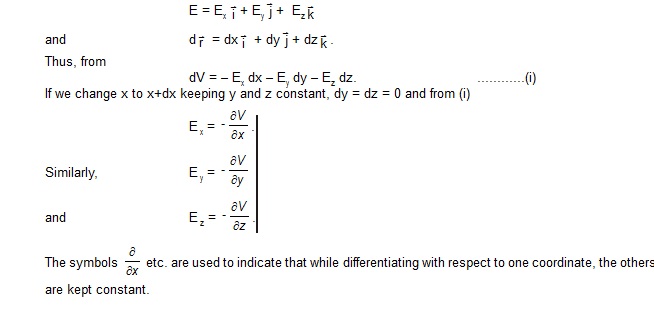
Worked out Examples
1. Charges 5.0 × 10–7 C, –2.5 × 10–7 C and 1.0 × 10–7 C are held fixed at the three corners A, B, C of an equilateral triangle of side 5.0 cm. Find the electric force on the charge at C due to the rest two.
Sol. 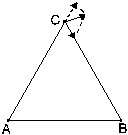
The force on C due to A
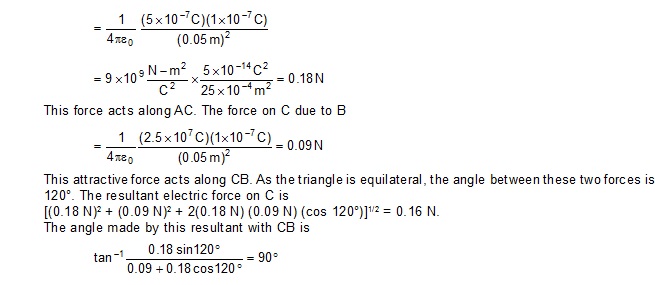
2. Two particles A and B having charges 8.0 × 10–6 C and – 2.0 × 10–6 C respectively are held fixed with a separation of 20 cm. Where should a third charged particle be placed so that is does not experience a net electric force ?
Sol. As the net electric force on C should be equal to zero, the force due to A and B must be opposite in direction. Hence, the particle should be placed on the line AB. As A and B have charges of opposite signs, C cannot be between A and B. Also, A has larger magnitude of charge than B. Hence, C should be placed closer to B than A. The situation is shown in figure.
Suppose BC = x and the charge on C is Q.

3. Three equal charges, each having a magnitude of 2.0 × 10–6 C, are placed at the three corners of a right-angled triangle of sides 3 cm, 4 cm and 5 cm. Find the force on the charge at the right-angle corner.
Sol. 
The situation is shown in figure. The force on A due to B is
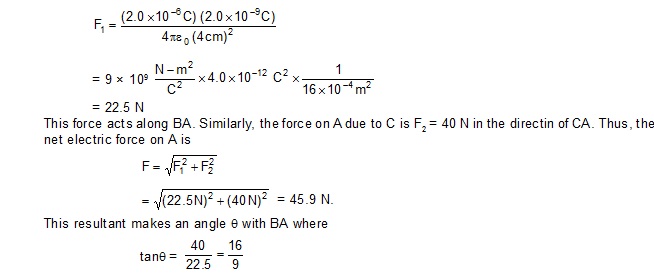
4. Two small iron particles, each of mass 280 mg, are placed at a distance 10 cm apart. If 0.01% of the electron of one particle are transferred to the other, find the electric force between them. Atomic weight of iron is 56 g/mol and there are 26 electrons in each atom of iron.
Sol. The atomic weight of iron is 56 g/mol. Thus, 56 g of iron contains 6 × 1023 atoms and each atom contains 26 electrons. Hence, 280 mg of iron contains
280mg x 6 x 1023 x 26 / 56g = 7.8 × 1022 electrons.
The number of electrons transferred from one particle to another
= 0.01/100 x 7.8 /1022 = 7.8 x 1018
The charge transferred is, therefore,
1.6 × 10–19 C × 7.8 × 1018 = 1.2 C.
The electric force between the particles is

This equals the load of approximately 2000 million grown-up persons ?
5. A charge Q is to be divided on two objects, What should be the values of the charges on the objects so that the force between the objects can be maximum ?
Sol. Suppose one object receives a charge q and the other Q – q. The force between the objects is
![]()
where d is the separation between them. For F to be maximum, the quantity
y = q(Q – q) = Qq – q2
should be maximum. This is the case when,
dy/dq = 0 or, Q – 2q = 0 or, q = Q/2
Thus, the charge should be divided equally on the two objects.
6. Two particles, each having a mass of 5 g and charge 1.0 × 10–7 C, stay in limiting equilibrium on a horizontal table with a separation of 10 cm between them. The coefficient of friction between each particle and the table is the same. Find the value of this coefficient.
Sol. The electric force on one of the particles due to the other is
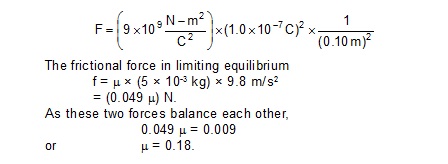
7. A vertical electric field of magnitude 4.00 × 105 N/C just prevents a water droplet of mass
1.00 × 10–4 kg from falling. Find the charge on the droplet.
Sol. The forces acting on the droplet are
(i) the electric force and
(ii) the force of gravity .
To just prevent from falling, these two forces should be equal and opposite. Thus,
q(4.00 × 105 N/C) = (1.00 × 10–4 kg) × (9.8 m/s2)
or q = 2.45 × 10–9 C.
8. Three charges, each equal to q, are placed at the three corners of a square of side a. Find the electric field at the fourth corner.
Sol. 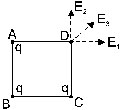
Let the charges be placed at the corners A, B and C (figure). We shall calculate the electric field at the fourth corner D. The field E1 due to the charge at A will have the magnitude q/4pie0a2 and will be along AD. The field E2 due to the charge at C will have the same magnitude and will be along CD.
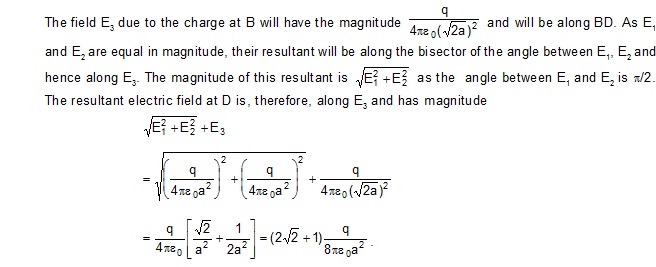
.
9. A charged particle of mass 1.0 g is suspended through a silk thread of length 40 cm in a horizontal electric field of 4.0 × 104 N/C. If the particle stays at a distance of 24 cm from the wall in equalibrium, find the charge on the particle.
Sol. 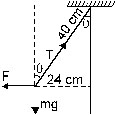
The situation is shown in figure
The forces acting on the particle are
(i) the electric force F = qE horizontally,
(ii) the force of gravity mg downward and
(iii) the tension T along the thread.
As the particle is at rest, these forces should add to zero.
Taking components along horizontal and vertical,
T cosq = mg and T sinq = F
or, F = mg tanq ...........(i)
From the figure,
sinq = 24/.40 = 3/5 .
Thus, tanq = . From (i),
q(4.0 × 104 N/C) = (1.0 × 10–3 kg) (9.8 m/s2) ,
giving q = 1.8 × 10–7 C.
10. A particle A having a charge of 5.0 × 10–7 C is fixed in a vertical wall. A second particle B of mass 100 g and having equal charge is suspended by a silk thread of length 30 cm from the wall. The point of suspension is 30 cm above the particle A. Find the angle of the thread with the vertical when it stays in equilibrium.
Sol. 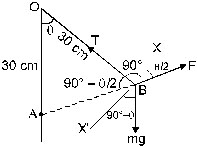
The situation is shown in figure. Suppose the point of suspension is O and let q be the angle between the thread and the vertical. Forces on the particle B are
(i) weight mg downward
(ii) tension T along the thread and
(iii) electric force of repulsion F along AB.
For equilibrium, these forces should add to zero. Let X’ BX be the line perpendicular to OB. We shall take the components of the forces BX. This will give a relation between F, mg and q.
The various angles are shown in the figure. As
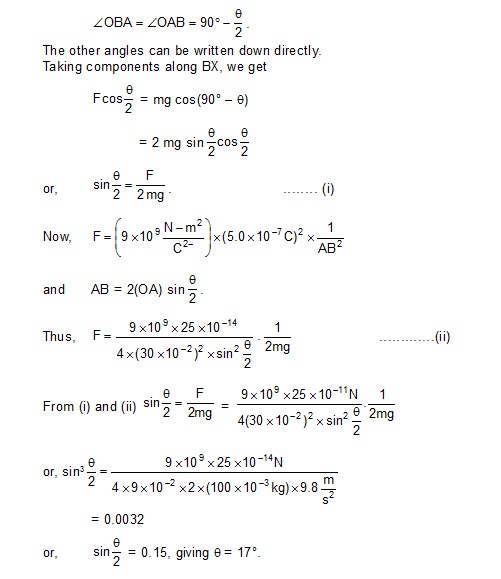
11. Four particles, each having a charge q, are placed on the four vertices of a regular pentagon. The distance of each corner from the centre is x. Find the electric field at the centre of the pentagon.
Sol. 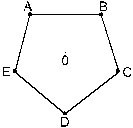
Let the charges be placed at the vertices A, B, C and D of the pentagon ABCDE. If we put a charge q at the corner E also, the field at O will be zero by symmetry. Thus, the field at the centre due to the charges at A, B, C and D is equal and opposite to the field due to the charge q at E alone.
The field at O due to the charge q at E is

12. Find the electric field at a point P on the perpendicular bisector of a uniformly charged rod. The length of the rod is L, the charge on it is Q and the distance of P from the centre of the rod is a.
Sol. 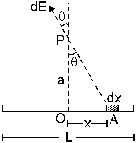
Let us take an element of length dx at a distance x from the centre of the rod (figure). The charge on this element is
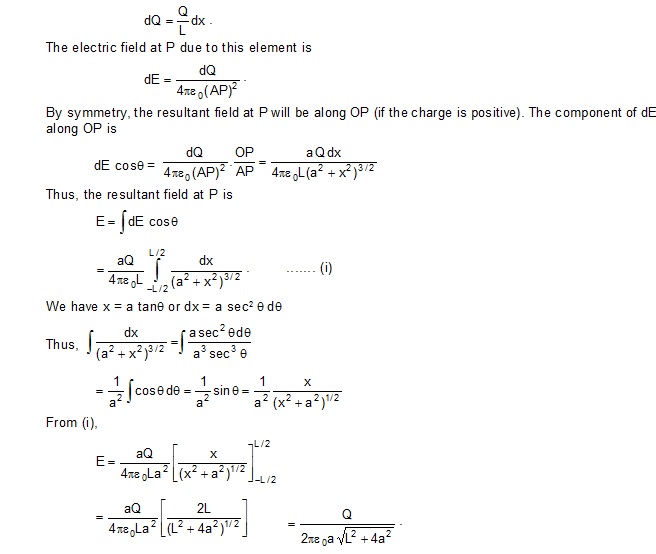
.
13. A uniform electric field E is created between two parallel, charged plates as shown in figure. As electron enters the field symmetrically between the plates with a speed v0. The length of each plate is l. Find the angle of deviation of the path of the electron as it comes out of the field.


14. In a circuit, 10 C of charge is passed through a battery in a given time. The plates of the battery are maintained at a potential difference of 12 V. How much work is done by the battery ?
Sol. By definition, the work done to transport a charge q through a potential difference V is qV. Thus, work done by the battery
= 10 C × 12 V = 120 J.
15. Charges 2.0 × 10–6 C and 1.0 × 10–6 C are placed at corners A and B of a square of side 5.0 cm as shown in figure. How much work will be done against the electric field in moving a charge of
1.0 × 10–6 C from C to D ?

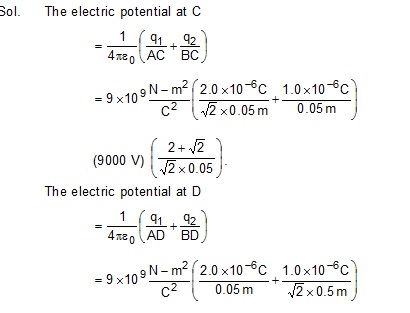

17. Three point charges q, 2q and 8q are to be placed on a 9 cm long straight line. Find the positions where the charges should be placed such that the potential energy of this system is minimum. In this situation, what is the electric field at the charge q due to the other two charges ?
Sol. The maximum contribution may come from the charge 8q forming pairs with others. To reduce its effect, it should be placed at a corner and the smallest charge q in the middle. This arrangement shown in figure ensures that the charges in the strongest pair 2q, 8q are at the largest separation.
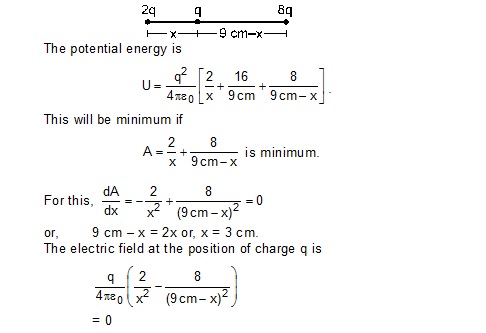
18. An HCl molecule has a dipole moment of 3.4 × 10–30 C–m. Assuming that equal and opposite charges lie on the two atoms to form a dipole, what is the magnitude of this charge ? The separation between the two atoms of HCl is 1.0 × 10–10 m.
Sol. If the charges on the two atoms are q, –q,
q(1.0 × 10–10 m) = 3.4 × 10–30 C-m.
or, q = 3.4 × 10–20 C.
Note that this is less than the charge of a proton. Can you explain, how such a charge can appear on an atom ?
19. Figure shows an electric dipole formed by two particles fixed at the ends of a light rod of length l. The mass of each particle is m and the charges are – q and + q. The system is placed in such a way that the dipole axis is parallel to a uniform electric field E that exists in the region. The dipole is slightly rotated about its centre and released. Show that for small angular displacement, the motion is angular simple harmonic and find its time period.

Sol. Suppose, the dipole axis makes an angle q with the electric field at an instant. The magnitude of the torque on it is
